






Glaritus 100IU/ml Injection
Manufacturer
Wockhardt Ltd
Salt Composition
Insulin Glargine (100IU)
Key Information
Short Description
Glaritus 100IU/ml Injection is a long-acting type of insulin used to treat types 1 and 2 diabetes mellitus in both adults and children. It provides a steady level of insulin in the body for an entire day and helps control blood sugar levels.
Dosage Form
Injection
Introduction
Glaritus 100IU/ml Injection can be prescribed alone or along with fast-acting insulin or other diabetes medicines. Your doctor or nurse will teach you the correct way of injecting it under the skin. You should use this medicine regularly as per the dose advised to get the maximum benefit. If you stop taking it, your blood sugar levels may rise very high which may put you at risk of serious complications. It is only a part of the treatment program that should also include a healthy diet, regular exercise and weight reduction as advised by your doctor.
Directions for Use
Your doctor or nurse will give you this medicine. Kindly do not self-administer.
Safety Information
Side Effects
Hypoglycemia (low blood sugar level) Peripheral edema Lipodystrophy Allergic reactions Injection site reactions Iching Rashes Weight gain
Alcohol Warning
It is unsafe to consume alcohol with Glaritus 100IU/ml Injection.
Breastfeeding Warning
Glaritus 100IU/ml Injection is probably safe to use during breastfeeding. Limited human data suggests that the drug does not represent any significant risk to the baby.
Pregnancy Warning
Glaritus 100IU/ml Injection is generally considered safe to use during pregnancy. Animal studies have shown low or no adverse effects to the developing baby; however, there are limited human studies.
Interacting Medicines
Benazepril Captopril Enalapril Fosinopril
How it works
Glaritus 100IU/ml Injection is a long-acting insulin that provides consistent all-day sugar control. It works like your body's natural insulin. Insulin facilitates reuptake of sugar in muscle and fat cells and also suppresses the production of sugar in the liver.
Quick Tips
Glaritus 100IU/ml Injection is injected under the skin. It needs to be injected once daily at the same time every day. Injection below the skin of the abdomen results in faster absorption than other injection sites. Injection sites must be rotated to prevent hard lumps from developing at one site. Exercise regularly Eat a healthy diet and take your other diabetes medicines (if prescribed) alongside. Regular monitoring of blood sugar levels is required while taking this medicine. Always carry some high sugar food such as sugar candy or glucose candy, fruit juice and glucose/glucon-D with you so that you can take it when you experience hypoglycemia symptoms such as cold sweats, cool pale skin, tremors, weakness, and anxiety.
Related Medicines

Basalog One Injection

Basugine 100Iu/ml Injection

Glaritus Dispopen 2

Glaritus 100IU/ml Injection

Basalog 100IU/ml Injection
Frequently asked questions
What kind of insulin is Glaritus 100IU/ml Injection?
Glaritus 100IU/ml Injection is a synthetic, human-like insulin. It provides long and steady (constant) blood sugar level control throughout the day, making it suitable for once daily administration. It's prescribed for type 2 diabetes mellitus in adults and children, as well as type 1 diabetes mellitus in adults and children.
How is Glaritus 100IU/ml Injection administered?
Glaritus 100IU/ml Injection is administered subcutaneously (just below the skin). Your doctor will provide training on correct injection technique and recommended injection sites. Always change your injection site within the chosen area of skin for every dose. For example, if you're injecting into your stomach, avoid puncturing the same point repeatedly. Choose a different site around 1cm away from previous injections. Switching sides can also help reduce complications like lipodystrophy (thickening of fat tissue). After one to two weeks, move to another area as advised by your doctor.
Can I take Glaritus 100IU/ml Injection twice a day?
Glaritus 100IU/ml Injection is long-acting and usually prescribed for once daily use. It can be taken at any time of the day, but try to maintain a consistent schedule.
What happens if I accidentally inject more than the prescribed dose of Glaritus 100IU/ml Injection?
If you have accidentally taken more than the prescribed dose, your blood sugar levels may drop too low (hypoglycemia). Hypoglycemia can range in severity from mild to severe. Monitor your blood sugar closely for the next 24 hours. Mild episodes of hypoglycemia often resolve with sugary foods such as candy, fruit juice, or glucose/glucon-D. However, it's crucial to consult your doctor to determine the best course of treatment. In severe cases of hypoglycemia, seizures (fits) or loss of consciousness may occur, which can be life-threatening and require immediate medical attention.
How should Glaritus 100IU/ml Injection be stored?
Keep this medication out of reach of children. Store unopened vials and pens in the refrigerator until the expiration date on the label. Never freeze or defrost a vial that's been previously frozen or thawed. If refrigeration is unavailable, store it at room temperature away from direct sunlight and extreme heat. It should appear as a clear, colorless solution free from particles.
In what circumstances will the dose of Glaritus 100IU/ml Injection need to be changed?
You should consult your doctor about adjusting your insulin dose in specific situations. This includes if you are ill, or experiencing changes in eating habits that may affect blood sugar levels. It's important to inform your doctor of any medications you're taking as some can interact with insulin and may require dose adjustments. Exercise, alcohol consumption, and stress can also impact your blood sugar levels. Consult your doctor for advice if pregnant or breastfeeding.
What are the serious side effects of Glaritus 100IU/ml Injection?
Serious side effects from Glaritus 100IU/ml Injection are rare. Allergic reactions, including rash, hives, itching, difficulty breathing (wheezing), rapid heartbeat, and low blood pressure can occur. Seek immediate medical help if you experience any of these symptoms. Other potential side effects include severe hypoglycemia (low blood sugar) that might cause dizziness, sweating, anxiety, confusion, headache, blurred vision, slurred speech, shakiness, fast heartbeat, seizures, and loss of consciousness. Some people may also experience sudden weight gain and swelling in their ankles or feet. Contact your doctor immediately if you observe these side effects.


